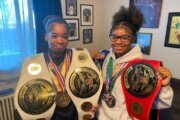LAS VEGAS (AP) — Adele, Mariah Carey and Garth Brooks tower over the Las Vegas Strip, peering out from billboards advertising their various casino residencies. But the 20,000 fans marching toward the glowing Sphere last week were there for a band that many Strip visitors have no idea exists.
Over the past 40 years, legions of dedicated Phish fans have followed the Vermont jam band no matter where it goes. This time, it happened to be Las Vegas, for four nights at the $2.3 billion immersive arena. No two Phish shows are the same, and while the band had played Vegas 26 times before, the Sphere offered a game-changing canvas for its signature light shows.
The fans came in sequined, glittery dresses and tie-dye alike, in button-down shirts and overalls printed with the band’s red doughnut logo. Once inside, they were greeted with a LED screen the size of a football field.
Over 68 songs over the four nights, co-creative director Abigail Rosen Holmes would use that expanse to drive fans across bold visual worlds inspired by the four states of matter: solid, liquid, gas and plasma. As Phish jammed, the Sphere’s screens became an art show, taking the audience through flowing streams of color and simple dots of light, around an enchanted lake and a field of psychedelic trees, and through a car wash (yes, a car wash).
“It gives me hope,” said Sean Marmora, 31, who traveled from New Jersey. “It’s inspiring that they’re pushing boundaries and doing things that they have never done before.”
Some displays were more abstract — during “Sand” and “Chalkdust Torture,” specks of light danced on screen in time to the music — while others were easier to discern: “Bathtub Gin” featured computer-generated people on floats made of donuts, pineapples and pizza slices in a wave pool. During “Maze,” a narrow line of video blew up into bits across the screen. For “Leaves,” hundreds of digital balloons joined the very real balloons flying up inside the Sphere.
“It was a very different Phish show, so special in its own right,” said Tim Urbashich, 38, from Wisconsin. “This is a whole evolutionary experience in what’s happening. They deserve visual representation of their music.”
Phish’s light shows are typically driven by Chris Kuroda, whom fans have nicknamed CK5 — as in, the fifth member of the band.
Kuroda was still heavily involved in the shows at the Sphere, albeit with a stripped-down light setup offsetting the screen. Phish frontman Trey Anastasio said Kuroda played a key role in fighting against the “tyranny of the wall” of visuals.
On Saturday night, the screen lit a digital version of the band ablaze during “Fuego,” eventually subsiding into a calm blue. As the real band jumped into “Golden Age,” Kuroda lit them in his signature soft purple and yellow spotlights.
Holmes says the production team learned to be looser over the course of the Vegas run, refining and adopting subtle changes to make the visuals more responsive to the music.
“This is such a new and different environment, where we started trying to make everything perfect. And then being more comfortable, taking chances and pushing things a bit further,” Holmes said. “I think Chris Kuroda and I were able to reach further and mesh better as the nights went on.”
As much as the Sphere shows will be remembered for the visuals, though, it’s the music that ultimately makes Phish.
No song was repeated, and the band took advantage of the ability to isolate sounds across the room’s 167,000 speaker drivers. Anastasio says he was proud the band could still go in without a plan. Most large visual concert experiences include a click track to know when to hit certain marks. Phish insisted on being able to improvise.
“I felt like if we didn’t have that element, it wouldn’t be a Phish concert,” Anastasio said.
At the end of Sunday night’s show, Anastasio vowed to return to the Sphere. Phish was only the second band to play it after U2 opened it with a 40-show run. Dead and Company are scheduled to play there this summer.
Meanwhile, Phish will release its 16th studio album, “Evolve,” in July, when it will also launch a summer tour.
“As long as the four of us are together and walking this planet, I would like to think that Phish exists and that we can keep playing,” McConnell said of the band’s stamina and longevity.
So much of the band’s time together is spent thinking about processes and new approaches, he said.
“So we don’t exactly know where it goes and where it’s going. But I have a good feeling that it’s going to go on for a long time,” he said. “I really hope it does.”
As long as Phish keeps going, so too will its community. Both Marmora and Urbashich were among the dozens of artists selling their Phish-inspired work at the PhanArt show that pops up at the band’s stops.
“We’re all trying here to find something special,” Urbashich said. “You have to open up your mind to the simplest things. It’s so out there and abstract. If you don’t give it patience you might not think it’s what you’re looking for.”
Copyright © 2025 The Associated Press. All rights reserved. This material may not be published, broadcast, written or redistributed.







